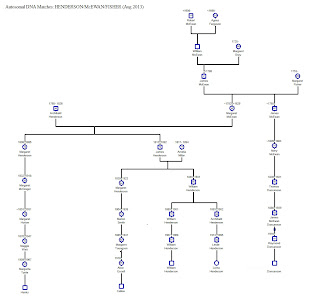

- #How can i sort my dna matches for free
- #How can i sort my dna matches how to
- #How can i sort my dna matches full
- #How can i sort my dna matches verification
Of the 251 “exact” matches shown, the haplogroup breakdown is shown below: Here’s what I found after sorting the spreadsheet.Įxact matches = 32, hardly the 251 displayed on the match page. As we talk about this, keep in mind that my client had a total of 5 mutations in the HVR1+HVR2 regions, so based on “0” differences, everyone on that list should share all of those mutations with no additional mutations. I clicked on the “download matches” button, which dumps everything into a spreadsheet, a wonderfully handy feature. That’s exciting to see, except it isn’t real. My client’s 251 matches at ancestry were all shown with “0” differences which means they are exact matches.

So, in essence, Ancestry has muddied their own waters.
#How can i sort my dna matches verification
Secondly, and probably the biggest issue is that Ancestry allows people to enter their own data from other labs into their data base, including their haplogroup, apparently without any verification process. We really don’t know how they do it, and they aren’t as forthcoming about these things as Family Tree DNA is. Part of the issue could be how Ancestry assigns haplogroups.

Then why does Ancestry show them as matches when a simple comparison would eliminate them? Will someone who is haplogroup H match someone who is haplogroup M or N or some other haplogroup?Īnswer: No, not an exact match, but they may share some common mutations. So, at Ancestry, and in other data bases outside of Family Tree DNA, we would expect to see matches to both haplogroup H and H1 (assuming the data base allows outside results to be input), and possibly some other H haplogroups as well, if the HVR1+HVR2 region mutations match those of our H1 person.
#How can i sort my dna matches full
The “1” part of H1 is determined by location 3010A, a position found in the coding region that can only be read by full sequence testing. Therefore, like in this case, we see a client whose haplogroup is H1. You didn’t think this was going to be easy did you?īecause Family Tree DNA is the only company to test to the full sequence level, their clients are going to have far more advanced, detailed and accurate haplogroup assignments than people who test at companies who only offer the HVR1+HVR2 regions. This has been a pervasive problem for a long time.ġ0 Point Question – If you match another person exactly on every location, HVR1&HVR2, must you have the exact same haplogroup? While working on a client’s mitochondrial DNA report, I came across the worst case I’ve seen in a long time of mismatches being shown as matches at. If you have any suggestions I’d love to hear them.Update: Ancestry no longer provides Y and mitochondrial DNA testing, but I’m leaving this article for historical context. As a BONUS, I’ve added a page where you can also track your genealogy correspondence as well.
#How can i sort my dna matches for free
If you’d like to have a look at my spreadsheet, you can download it for FREE HERE. One other thing to keep in mind is that each of the DNA companies offers you space to write notes. made contact (Y/N) in other words did they reply or did you reply if they made the first contactįor me, it tracks just about everything, and it’s about keeping as much info in one place for ease of access.aka (if it’s different from their name).

#How can i sort my dna matches how to
One is the info tab that tells you how to use the worksheet. The spreadsheet has three tabs across the bottom. So keeping track of correspondence can be a struggle.Ībout nine months ago, one of my followers asked me this question, and I passed along the tool that I use, so I thought perhaps I should tell you about my spreadsheet. I also administer the kits for my parents, my brothers, my sons, as well as many of my aunts and uncles and cousins. Ancestry, MyHeritage, Family Tree DNA (FTDNA), 23andMe, and LivingDNA. In fact, I’ve tested at every company that I think it’s of value to test at. I’ve been working with my DNA matches for over ten years now.


 0 kommentar(er)
0 kommentar(er)
